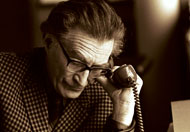Ken Garland’s contribution to: ‘Ernest Hoch remembered by his friends. The importance of Ernest’, Designer, September 1985 (London: Society of Typographic Designers) pp. 20–21
1959: He has come to be briefed, over lunch, on the design of a cover for Design magazine, of which I am the art director at the time. It is a simple enough task but for Ernest it raises all sorts of questions that have not occurred to me. We range over colour theory, printing methods, exigencies of format, paper substance and ink. After that we get on to the joint and particular responsibilities of the designer, the publisher, the printer, the artist, their place in society, in history. Some two hours later, the cover is casually mentioned: it is apportioned its proper place in the general scheme of things; then it’s on to the DIN paper series (still a matter of hot disagreement at this time) and the metrication of typeface size (‘You can’t be serious, Ernest?’). Finally, at 3.30, with the waiters at Menzi’s fish restaurant ostentatiously clearing crumbs from our table and pushing brooms between our legs, we give up. Or rather, adjourn: for us, this is the first instalment of a 24-year-long debate.
1969: Ernest is sitting in his office at Coventry, where he is Head of the Faculty of Art and Design, Lanchester Polytechnic. He is almost invisible behind piles of memos, minutes of committees, progress records, working party reports; he is being persecuted by the appalling busybodies who infest the administration of such places, snowed under by their white terror. It is 9pm and we are alone in the building. He is longing to get away somewhere where we can continue our debate, but first he must impose some order on his pending tray. ‘This place badly needs system, standardization, clear thinking,’ he declares. He plunges back into the tower of bumf and it topples all over the office floor. He is not surprised: it is obviously a regular occurrence. What this place really needs, I think sadly, is a ruthless, devious, scheming master of low cunning and high intrigue. Whatever can this kind, loving, innocent man be doing in this fearsome place? At last he gives up and we leave. An hour later, locked in discussion, we forget for a while that education is, for many people, not about teaching, or learning, or any such unquantifiables, but about budget allocations, interfaculty interfaces and documentary throughput.
1979: One of Ernest’s students at the University of Reading, where he is now Reader in Typography, has just approached him with a copy of a project brief in her hand. ‘Ernest’, she says hesitantly, ‘I’m very sorry but I don’t quite understand this part of your brief. Could you …?’ ‘No need to apologize,’ he says, with pleasure. ‘If you don’t understand, it’s my fault and not yours. Now, let’s settle down over here and go into it properly, and we’ll find out where I’ve gone wrong’. She smiles, vastly reassured; he’s in his element; he’s found his spiritual home, thank God.
And this is the way I like to think of him. In debate.

Ernest Hoch. Photo: Richard Southall

